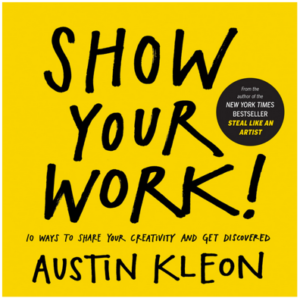Wednesday, January 18, 2017

I was thrilled when Deb Hemley (
@dhemley) asked if I would be interested in publishing her blog post about writing a nonfiction book, which she based on the principles in Austin Kleon’s book,
Show Your Work. This book has a spot close to my desk. Every time I see it, I’m reminded to share my message. In this post, Deb explains how writers can use Kleon’s principles.
Recently I came across the book
Show Your Work! By Austin Kleon. I read the book from beginning to end in one sitting. Kleon’s book inspired me…and continues to inspire me.
The principles he offers in
Show Your Work! can be applied to artists of all types. The book provides a ten-principle conceptual framework for writers.
I discuss the first five in this post.
1. You Don’t Have to Be a Genius

Kleon begins
Show Your Work! by giving validity to being an “amateur”—not something we hear people talk about every day.
He writes, “The world is changing at such a rapid rate that it’s turning us all into amateurs. Even for professionals, the best way to flourish is to retain an amateur’s spirit and embrace uncertainty and the unknown.”
How would you apply being an amateur to your writing?A great example comes from author
Haruki Murakami, who used the “amateur” position as a jumping-off point for his recent non-fiction book
Absolutely on Music: Conversations with Seiji Ozawa. In the introduction to the book Murakami describes how the two friends had been listening to music and talking about one thing or another when Ozawa “told me a tremendously interesting story….” Murakami thought what a shame it would be to “let such a fascinating story evaporate, somebody ought to record it and put it on paper.”
Thus, the idea for the nonfiction book was formed. In fact, Murakami uses the word amateur multiple times in the introduction to set the stage for the book. “I tried my best to remain an honest and curious amateur listener on the assumption that most of the people reading this book would be amateur music fans like me.”
Through recorded and transcribed conversations with Maestro Ozawa, Murakami’s book took shape. The chapters are even titled, First Conversation, Second Conversation through their sixth conversation.
How can you take an interest of yours (something that you don’t have to have a great deal of experience in) and use it as a framework for your book?2. Think Process, Not Product
Kleon advocates for artists to take advantage of the Internet and social media. “An artist can share whatever she wants, whenever she wants, at almost no cost…she can blog about her influences, inspiration and tools…and form a unique bond with her audience.
Think about one great influence (person, place or thing) in your life and try writing about it today—and sharing that work.3. Share Something Small Every Day
Regardless of the stage at which you find your nonfiction book project, you can write something small about your process. Let’s say that the book you’re writing requires research that has helped steer your direction, share what you’ve learned. Maybe something you came across during your research took you down a different path; you’re not sure yet whether it’ll be useful for your book, but it’s a tidbit you can share.
Regardless of if you’ve found a new way to simulate your creativity or your struggling to write daily, share something about the process.
Writers want to tell good stories, and we all have them whether we realize it or not. Click To Tweet
4. Open Up Your Cabinet of Curiosities
In this step, Kleon describes the process of opening our cabinet of curiosities to think about the sorts of things that fill our heads. This includes what we read, subscribe to, listen to, what we collect, what we hold near and dear.
A couple of years ago I attended a five-day writer’s workshop. On day two the instructor provided a writing prompt, and the next thing I knew I had written a few pages about the watch I’ve been wearing for the past eighteen years. There was a story about the watch—one I hadn’t quite put together or articulated to anyone or myself until then. I received a great gift when I found the inspiration for a short piece had been on my wrist the whole time.
What’s in your cabinet of curiosity that you can write about?5. Tell Good Stories
Nonfiction writers want to tell good stories, and we all have them whether we realize it or not. Kleon writes, “Everybody loves a good story, but good storytelling doesn’t come easy to everybody…study the great stories and then go find some of your own.”
I’m often amazed about the vast topics about which people write. Five uniquely different books sit on my desk at this very moment: a book about the power of not knowing (
Nonsense); another about a woman who adopted and raised a hawk (
Hawk); one more about conversations an author had with Maestro Seiji Ozawa (
Absolutely on Music); a graphic novel that teaches people how to draw (
The Drawing Lesson); and a guide to the journey of self-discovery (
Creative Visualization for Writers).
Just flipping through the pages, I’m momentarily reminded of the variety of stories these authors chose to tell and feel that much closer to accessing stories of my own. These sparks of inspiration can serve to remind us of the past and present and also can take us to the future (literally and figuratively).
What stories are accessible to you right now? What other places will you look? Feel free to comment below on what you’re moved to write and share…and include the link to that work below.
About the Author
 Deb Hemley
Deb Hemley writes memoir, personal essay, short fiction, and articles about social media. She has published pieces in
Biographile, Hippocampus Magazine, All That Matters, and
Survivor’s Review. You can follow her on Twitter
@dhemley.
The post
A Field Guide to Writing a Nonfiction Book (with a Lot of Help from Austin Kleon) appeared first on
Write Nonfiction NOW!.
Nina Amir, the bestselling author of How to Blog a Book and The Author Training Manual, is a speaker, a blogger, and an author, book, blog-to-book, and high-performance coach. Known as the Inspiration to Creation Coach, she helps creative people combine their passion and purpose so they move from idea to inspired action and positively and meaningfully impact the world as writers, bloggers, authorpreneurs, and blogpreneurs. Some of Nina’s clients have sold 300,000+ copies of their books, landed deals with major publishing houses and created thriving businesses around their books. She is the founder of National Nonfiction Writing Month, National Book Blogging Month, and the Nonfiction Writers’ University. As a hybrid author she has published 19 books and had as many as four books on the Amazon Top 100 list at the same time. Her most recent book is called Creative Visualization for Writers, and tomorrow her 19th book will be released, The Write Nonfiction NOW! Guide to Creativity and Flow. Find all her books at booksbyninaamir.com or find out more about her at ninaamir.com.